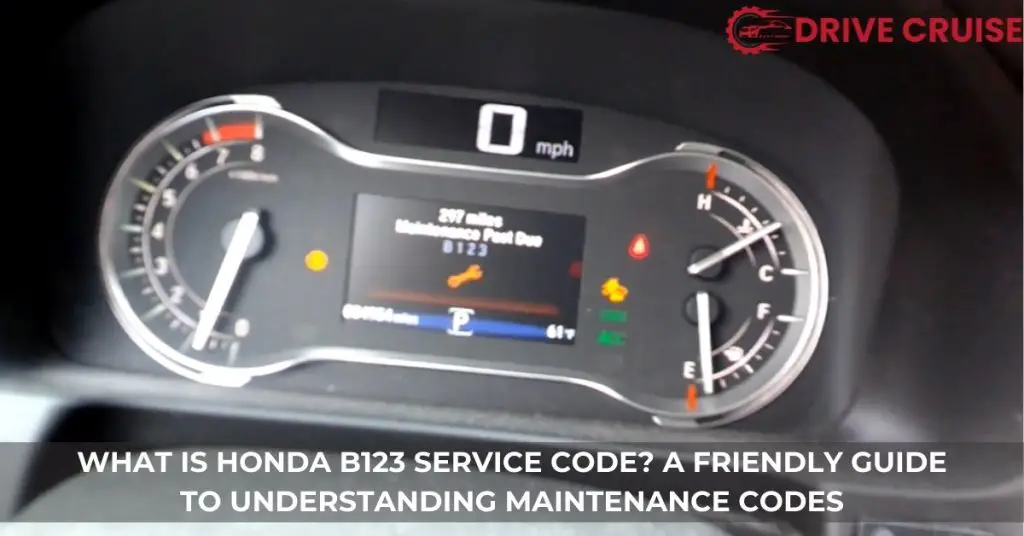We’ve all been there, cruising along in our Honda, when suddenly a mysterious code pops up on the dashboard. It’s the Honda B123 service code, and if you’re scratching your head wondering what it means, you’re not alone. This code is more than just a random combination of letters and numbers; it’s a direct message from your car telling you it’s time for some attention.
Understanding what the B123 service code entails can save us from unnecessary worry and ensure our vehicle continues to run smoothly. It’s a reminder that our cars, much like us, need regular check-ups to stay in top shape. So let’s dive into what this service code means and why it’s important for your Honda’s health and longevity. Trust us, it’s not as daunting as it sounds, and we’re here to guide you through it.
Understanding Honda B123 Service Code
After discussing the importance of regular vehicle check-ups and the role of service codes in maintaining the health of your Honda, let’s dive deeper into what the B123 service code specifically means. This code is a combination of letters and numbers that Honda uses to indicate certain maintenance tasks that need attention. Each character in this code has a specific meaning, correlating to a different type of service required for your vehicle.
- “B” points to necessary maintenance related to your vehicle’s oil and filter. It indicates that it’s time for an oil change, oil filter replacement, and a comprehensive inspection of various vehicle components, including brakes, parking brake adjustments, and other fluid levels.
- The number “1” signals the need for a tire rotation, ensuring that tire wear is even across all tires, which helps extend their life and maintain vehicle safety.
- “2” represents the replacement of the air cleaner element, checking the drive belt, and replacing the dust and pollen filter. This is crucial for maintaining the engine’s performance and ensuring the air inside your vehicle remains clean.
- “3” denotes the replacement of transmission fluid and transfer fluid for vehicles equipped with AWD. This ensures smooth gear shifts and helps prevent premature wear of the transmission components.
By translating the Honda B123 service code, we understand the comprehensive nature of this particular maintenance request. It covers essential aspects such as oil changes, tire rotations, and filter replacements, alongside checking critical fluids that ensure the smooth operation and longevity of your Honda. Following these maintenance guidelines when the B123 service code appears on your dashboard will help keep your vehicle running efficiently and reliably.
Components of B123 Service
Given the foundational understanding of the Honda B123 service code’s role in keeping a vehicle in top condition, we’re eager to unpack each component’s specifics. The “B123” service showcases a comprehensive approach to vehicle maintenance, addressing various systems to ensure your Honda operates smoothly and efficiently.
B: Oil and Filter Change
The “B” in B123 emphasizes the necessity of changing the engine oil and oil filter. Oil is the lifeblood of the engine, providing the necessary lubrication to reduce friction between moving parts, while the filter captures harmful debris. This service ensures the engine continues to run efficiently, extending its lifespan.
1: Tire Rotation
Tire rotation, denoted by “1”, plays a critical role in maintaining balance and ensuring even tire wear. By switching the positions of your vehicle’s tires, we ensure they wear evenly, prolonging their life and maintaining optimal driving conditions. Regular tire rotation also contributes to balanced handling and improved fuel efficiency.
2: Air Cleaner and Cabin Filter Replacement
The second component, “2”, focuses on replacing the air cleaner element and the cabin air filter. The air cleaner element prevents contaminants from entering the engine, while the cabin air filter ensures the air inside your vehicle remains clean and free of pollutants. This service enhances both engine performance and passenger comfort.
3: Transmission Fluid Change
Finally, “3” underscores the importance of changing the transmission fluid. This fluid facilitates smooth gear shifts by lubricating the transmission’s moving parts. Over time, it degrades, necessitating replacement to prevent transmission wear and ensure smooth vehicle operation.
By adhering to the B123 service code, we help ensure your Honda vehicle’s systems are meticulously maintained, contributing to its reliability, safety, and longevity. Each component of this service code is pivotal, working in harmony to keep your vehicle performing at its best.
How Often Should You Service Your Honda?
After understanding the Honda B123 service code, it’s key to determine the right frequency for these services to keep your Honda in prime condition. The timeline for servicing your Honda varies based on different factors like model, year, and how you use your vehicle, but there are general guidelines to follow.
For the “B” code, including oil and filter maintenance, we recommend every 5,000 to 7,500 miles. This interval ensures your engine remains efficient and reduces wear over time. Remember, clean oil is crucial for engine health, so it’s best not to delay this service.
Regarding the “1” code for tire rotation, aligning this service with your oil change schedule is a smart move. This synchronicity helps in maintaining tire balance and ensures even tire wear, contributing to safer driving conditions and extended tire life.
For the “2” code, which involves air cleaner and cabin filter replacements, doing so every 15,000 to 30,000 miles is advisable. This range accounts for different air quality conditions your Honda might encounter. Fresh filters support optimal engine performance and maintain air quality inside your vehicle, enhancing comfort for all passengers.
Lastly, the “3” code for transmission fluid changes generally requires attention every 30,000 to 60,000 miles. However, this can vary widely based on your vehicle’s specific type and usage. Ensuring your transmission fluid is in good condition aids in smooth gear shifts and can prevent costly repairs down the line.
We always recommend consulting your Honda’s owner manual or a professional mechanic for the most accurate maintenance schedule tailored to your car’s specific needs. Staying ahead with regular maintenance not only keeps your Honda running smoothly but also preserves its value over time.
DIY Vs. Professional Service
Deciding between handling the Honda B123 service code maintenance tasks ourselves or entrusting them to a professional service boils down to a few key considerations. We recognize the allure of DIY maintenance: it can be more cost-effective, offers a personal sense of satisfaction, and provides a deeper understanding of our vehicle’s functioning. Performing oil and filter changes, tire rotations, and even air filter replacements are within the grasp of many car enthusiasts with basic tools and a bit of patience. Following the vehicle’s manual, we can address these B123 components with confidence, especially if we aim to save money in the short term.
However, it’s crucial to weigh these advantages against the expertise and precision a professional service offers. Transmission fluid changes, noted under “3” in the B123 code, exemplify maintenance that might be better left to professionals due to the need for specialized tools and knowledge about the Honda’s specific model and transmission type. Professionals can also spot potential issues that aren’t immediately apparent to the untrained eye, potentially saving us from costly repairs down the line.
Moreover, maintaining a documented history of professional services can enhance our Honda’s resale value, offering peace of mind to future buyers about the vehicle’s upkeep. This aspect is particularly significant for those of us planning to eventually sell our car.
In essence, while we can manage some B123 service tasks on our own, certain elements, especially those requiring specialized knowledge or equipment, are best handled by professionals. This approach not only ensures the work is done correctly but also helps in maintaining, and possibly even enhancing, the vehicle’s longevity and value. Ultimately, our decision should align with our comfort level, expertise, and the importance we place on the long-term health and value of our Honda.
Saving on B123 Service Costs
Tackling the B123 service code doesn’t have to break the bank. With a strategic approach, we can keep our Honda in top shape while also being mindful of our budget. The choice between DIY maintenance and hiring professionals plays a crucial role in managing expenses. Here, we’ll explore options to minimize the costs associated with the B123 service without compromising quality.
Opt for DIY When Possible
Engaging in DIY for certain components of the B123 service can significantly reduce costs. Oil and filter changes, as well as air and cabin filter replacements, are relatively straightforward tasks that we can handle with basic tools and a bit of know-how. Online tutorials and manuals specifically tailored to Honda vehicles make these jobs even easier, allowing us to save money on labor.
Source Parts Wisely
Buying filters and fluids in advance from reputable suppliers can lead to substantial savings. Consider purchasing these items online or from wholesale retailers, where prices are often lower than at the dealership. Opting for high-quality aftermarket parts instead of OEM parts can also reduce costs without sacrificing performance.
Seek Competitive Quotes
For more complex services like the transmission fluid change, it’s smart to shop around and get quotes from several mechanics. Rates can vary widely between dealerships and independent shops, so looking for the most competitive offer is key. However, ensuring the mechanic is experienced with Honda vehicles is essential to avoid potential issues.
Consider Service Bundles
Some service centers offer package deals that bundle several maintenance tasks at a discounted rate. These bundles can provide substantial savings compared to paying for each service separately. Always inquire about available packages when scheduling maintenance.
Maintain and Monitor
Regularly checking our Honda’s vital fluids and components can prevent minor issues from escalating into costly repairs. Early detection and maintenance can also prolong the intervals between needing professional services, ultimately saving money in the long run.
Through these strategies, maintaining our Honda’s health following the B123 service code can be more budget-friendly, ensuring our vehicle runs smoothly without draining our wallet.
Conclusion
We’ve walked through the ins and outs of the Honda B123 service code and how sticking to it can really make a difference in keeping our cars running smoothly. We’ve seen that while there’s a place for professional servicing, there are also plenty of ways we can take matters into our own hands to save some cash without cutting corners on quality. By being smart about how we approach maintenance—from choosing to do some tasks ourselves to shopping around for the best deals on more complex services—we’re not just keeping our cars in top shape; we’re also ensuring they hold their value over time. Let’s keep our Hondas happy with a little knowledge and the right care.
Related Posts:
- What is Honda A1 Service Code and How to Understand It
- What is Honda A13 Service Code: A Friendly Guide
- What is Honda A15 Service Code? A Friendly Guide to Understanding It
- What is Honda A123 Service Code? A Friendly Guide to Understanding Honda Maintenance Codes
- What Is Honda A137 Service Code? Your Quick Guide to Understanding It
- What is Honda B12 Service Code: A Friendly Guide
- What is Honda B123 Service Code? A Friendly Guide to Understanding Maintenance Codes
- What is Honda B125 Service Code: A Beginner’s Guide
- What is Honda B135 Service Code? A Friendly Guide to Understanding It
- What is Honda B137 Service Code? A Friendly Guide to Understanding Your Honda’s Maintenance Needs







